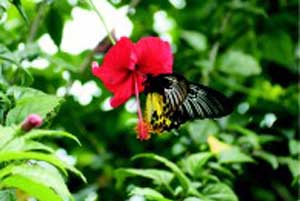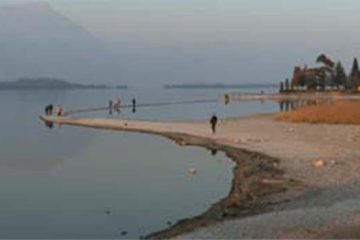Dr. M A Bashar
 Ecosystem itself is the phenomenon of interaction between biotic and abiotic factors in an area. This interaction means both of the factors in an area of the biosphere are equally “interacted” to form and run the system. But apparently plants are the primary phase as producers and successive phases are completed by animals as the consumers. So, plants in the system are treated collectively as the first trophic level and the animals as the successive trophic levels. These animals again provide some backward support to the plants for their multiplication and sustenance to form the final shape of an ecosystem and its functioning.
Ecosystem itself is the phenomenon of interaction between biotic and abiotic factors in an area. This interaction means both of the factors in an area of the biosphere are equally “interacted” to form and run the system. But apparently plants are the primary phase as producers and successive phases are completed by animals as the consumers. So, plants in the system are treated collectively as the first trophic level and the animals as the successive trophic levels. These animals again provide some backward support to the plants for their multiplication and sustenance to form the final shape of an ecosystem and its functioning.
The two aspects (plants and animals) come together to act as a single factor to be acted with abiotic factors in an ecosystem. And that is why, in an ecosystem plant-animal interaction stands as a major and vital part. This functional part is very much dependent on the question of “species richness and species assemblage” in an area of the biosphere. Some animals are found to play a very vital role in the sustenance of such species richness and species assemblage by showing their characteristic behaviours and activities. The Environmental Biology and Biodiversity Lab. (EBBL) of Dhaka University has carried out some experiments on the fact of the interaction between the two biotic aspects (the plants and animals) and found some important and interesting information on the question of functioning of forest ecosystem and on its sustenance and ecosystem health. Very recently experiments are made on the birdwing butterflies in a forest of Bangladesh. In the study, it is found that the birdwings can create a situation for (ecological condition) generating species assemblage and species richness in the forest.
There are only two birdwings in Bangladesh. As they are very much specific on their host plant selection, they are habituated to be confined in the certain forest ecosystem and specialized in maintenance of special life style. These butterflies are large-bodied and comparatively slow fliers but almost restless in the morning half of the day. Generally in the mid-day they remain in “resting” under the shade trees and that is why they need special type of shade trees. They do not feed on all flowers found in the vicinity of their habitats, only some selective plant-flowers provide them suitable structure and nectar storage. The flowers are visited by the butterflies in the morning and evening. It is to be noted that the plant-flowers visited by the butterflies are entomophilous and pollination in them is carried out by the butterflies.
The birdwings pass through four stages to complete their life cycle. The egg, larva, pupa and adult stage. They are called poison-eaters, as their larval stages have to depend on such specific plants as food sources that contain poison like aristolochic acid I and aristolochic acid II. The larva cannot develop on any other plants. We know that all butterflies are phytophagous and have to depend on respective specific plant. These plants are called host plants. It is obvious that the birdwings have different life-stages; similarly the host plants have different life stages like seedling stage, vegetative stage, pre-flowering stage, reproductive stage, fruitification stage, maturing stage and the post maturing stage. In the insect, the life-stages are known as phases of life cycle and the stages in the plants are called phenological stage of plants.
There is a synchronization of coincidences between the life stages of the insects (birdwings) and the phenological stages of their host plants in the wild state. Both (the plant and the animals) are wild organisms. It happens that, these butterflies are found only in some selected forests in Bangladesh as their host plants and other related (nectar and shelter) plants are found there only. It is to be noted that these plants are seriously endangered even in the forests of the country. This coincidence of synchronization between two biotic factors in ‘dynamic situation’ is the key factor to keep a forest healthy and make it sustainable. Very recently the EBBL University of Dhaka has identified the fact of ‘dynamic situation’ in the forest ecosystems. The present write up deals with the fact.
As it is already told, the host plant of birdwings is wild and grows in the forests. The host plant habitat where it grows always stands as an association of different plant species. The habitat of the host plant requires a special condition in the forest as not to be disturbed at least by the humans. The plant population needs about ten to fifteen other plant species for their healthy survival in nature. It needs four/five species of vines associated with it; different cane species to protect it from the disastrous calamities; different kinds of canopy trees for its strong support to get the top height in the forest vegetation (as the butterfly does not lay eggs on the low height in the forest vegetation); and in its habitat needs very large trees like chapalish (Artocarpus chaplasha) and jam tree (Syzygium cumini) to be shaded by them from direct sunlight. The host plant does not grow well under direct sunlight. They are very touchy in nature.
Birdwings are not very swift fliers. They are selective to the few plants for nectar collection, and also selective to have only a few plants as shelter plants during unusual hours in the day or in the varied climatic conditions. They need very selective nectar plants in the adult stage for survival. On the other hand, they are habituated to maintain territory around their host plant population. So the nectar plants should have their distribution and abundance in the vicinity of the host populations.
The birdwings need strong species assemblage of the wild plants in a forest ecosystem as their host plants, nectar plants and shelter plants. These three different types of plant species they need to survive themselves in good condition in nature. On the other hand, the birdwings play a great role in the question of plant pollination and also in the fact of gene-flow activities in the plant population, especially in the forest ecosystem where they are confined on the especial types of plants for their life-style maintenance.
The gene-flow activities are carried for maintaining healthy plant population in the forest ecosystem. In this way when plant populations are ensured in a forest ecosystem, the successive trophic levels, meaning the availability of different kinds of consumer animals is ensured. Consequently, flora and fauna are ensured to have their well-established habitats. When interactions between plants and animals, and animals and plants, stand very normal in a forest then the ecosystem remains sound. And that ecosystem can produce a balanced environment. Environmental soundness or environmental disturbance starts at atomic or very micro level, but it shows its vital impact at the species and community levels.
Man becomes victim of environmental disasters or environmental degradation at the community level. It is obvious that environmental soundness must be ensured at the micro level. Then it is possible to maintain at the community level. We see scientifically that a single species of the butterfly like the birdwings plays a great role in the questions of species richness and species assemblage in an ecosystem. How it maintains the synchronization of coincidences between the life stages of its own and the phonological stages of the related plants (host, nectar and shelter plants) for maintenance of plants species assemblage, richness and gene-flow activities in tied-up natural methods. In the abstract it could be said that the birdwings’ life-style and abundance in a forest enrich the multispecies assemblage through by interaction between two biotic aspects (the butterfly and related plants) in nature. Consequently environmental soundness in an area at the molecular level sustains.
(Article originally published on The Daily Star)
The writer is Professor, Department of Zoology and ex. Dean, Faculty of Biological Sciences, University of Dhaka.



